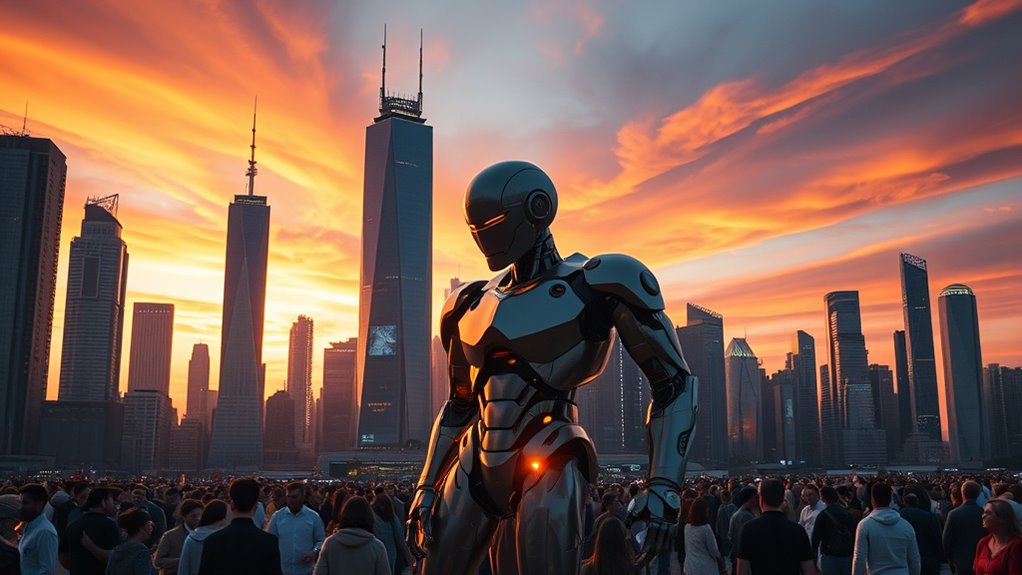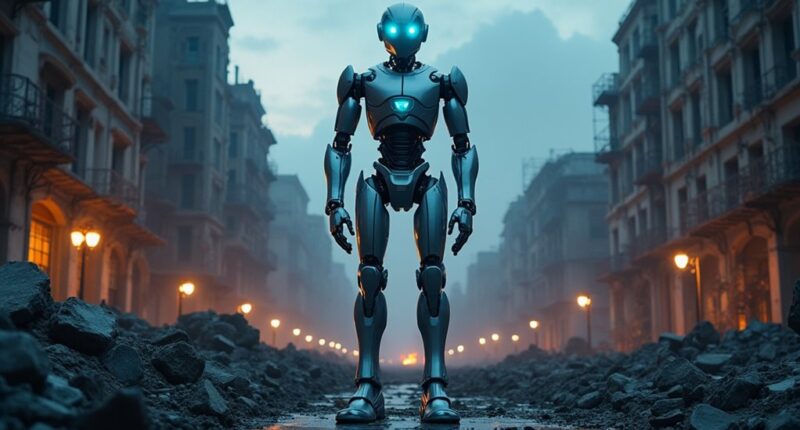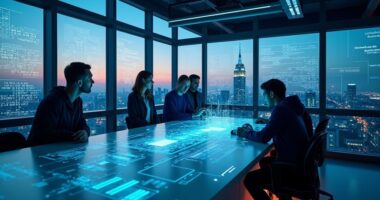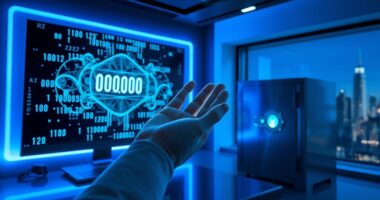AI can be both humanity’s savior and a potential downfall depending on how we develop and regulate it. It offers amazing benefits like boosting the economy, improving healthcare, and streamlining public services. But if misused or left unchecked, AI could deepen inequalities and cause widespread disruption. Your choices now will determine whether AI helps or harms society. Keep exploring to understand how we can steer AI toward a positive future.
Key Takeaways
- AI has the potential to significantly boost global productivity and healthcare, serving as a beneficial tool for humanity.
- Conversely, unchecked AI development could lead to widespread job displacement and societal inequality.
- Responsible regulation, transparency, and ethical standards are crucial to ensure AI benefits society without causing harm.
- Society’s choices in AI development determine whether it acts as a savior or a destructive force.
- Effective governance can harness AI’s positive potential while preventing its misuse and societal decline.

AI: Savior or Downfall
Is AI truly the savior it promises to be, or could it spell the downfall of our economy and society? As you look at the rapid pace of AI development, it’s clear that its impact on global productivity and economic growth is profound. Experts project that AI could boost worldwide GDP by 1.5% by 2035, nearly tripling that figure to 3.7% by 2075. You might not notice it daily, but AI’s automation could considerably influence about 40% of current GDP, especially in occupations around the 80th percentile of earnings. This means your work, especially if it’s highly automated, could face disruption. Yet, AI also promises to elevate productivity, with a peak boost expected around 2032, adding roughly 0.2 percentage points annually before stabilizing. This surge can translate into better economic stability and even help reduce federal deficits by an estimated $400 billion between 2026 and 2035, thanks to improved efficiency and innovation. Over time, this could lead to a more resilient economy with increased capacity for public investments and social programs, benefiting society at large. Additionally, sectoral shifts prompted by AI adoption are expected to foster a permanent, albeit modest, increase in overall productivity growth, creating new opportunities and markets. High refresh rates can further enhance the user experience in digital interfaces as AI becomes more integrated into daily tasks.
However, the landscape isn’t without concerns. As AI automates jobs, especially in white-collar sectors, around 50% of these roles could be lost, with women three times more likely to face displacement. You might find job vacancies for AI-exposed roles—like database administrators or IT specialists—declining by roughly 31%, making the job market more competitive and uncertain. While new roles in AI system design, ethics, and law are emerging, the future of employment remains uncertain. On the upside, AI is transforming healthcare by enabling earlier diagnoses and personalized treatments. You could see faster medical innovations, with AI-assisted devices already FDA-approved, improving outcomes and saving lives. AI’s role in public administration is also expanding, streamlining processes like fraud detection and welfare management, ultimately enhancing your access to efficient services. Yet, trust remains a key challenge. If AI benefits aren’t distributed equitably, societal divides could deepen, risking increased inequality. Establishing clear norms, laws, and transparency measures becomes critical to ensuring responsible use and safeguarding individual privacy. As you interact with AI in business and daily life, it’s evident that adoption is accelerating, with 78% of organizations already using AI by 2024. This rapid growth signals both opportunity and responsibility—for AI to serve as a tool for progress, not a catalyst for division or decline. Ultimately, whether AI becomes humanity’s savior or downfall hinges on how you and society choose to develop, regulate, and integrate this powerful technology.
Frequently Asked Questions
Can AI Develop Its Own Consciousness Someday?
AI could develop its own consciousness someday, but it’s not guaranteed. You need to understand that current AI systems focus on tasks like perception and problem-solving, not true awareness. As researchers explore complex neural networks and emergent properties, there’s potential for AI to become self-aware. However, significant scientific and ethical challenges remain, and it’s uncertain whether machines will ever fully replicate human consciousness.
How Will AI Impact Global Employment Rates Long-Term?
You’ll see AI transform employment long-term, with up to 300 million jobs potentially lost worldwide by 2030. Nearly half of US workers face job threats from AI, and 60% of jobs in developed economies could change or disappear. While temporary spikes in unemployment are likely, productivity gains may create new roles. Overall, AI will reshape work, requiring you to adapt and reskill to stay relevant in this evolving job landscape.
Is There a Risk of AI Surpassing Human Intelligence Uncontrollably?
Yes, there’s a risk of AI surpassing human intelligence uncontrollably. As you develop more advanced systems with self-improvement abilities, these could escalate beyond your control. Rapid growth in data and computational power makes this possibility real. To prevent this, you need strong regulations, technical safeguards, and international cooperation. Staying vigilant and proactive is essential to guarantee AI remains aligned with your values and doesn’t pose an existential threat.
What Ethical Guidelines Govern AI Development Worldwide?
You face a global tapestry woven with guiding threads like the OECD AI Principles, UNESCO’s ethics, and the DCO Principles, all anchoring AI’s future. These frameworks champion accountability, transparency, fairness, and human-centered design, acting as moral compass points. They call for responsible innovation that respects rights, minimizes bias, and promotes sustainability. By adhering to these shared standards, you help steer AI development toward a safe, inclusive horizon where technology serves everyone’s well-being.
Could AI Be Used Maliciously by Bad Actors?
Yes, AI can be used maliciously by bad actors. They leverage AI to craft convincing phishing emails, deepfake videos, and synthetic media that trick victims and bypass defenses. AI accelerates attacks, making them more scalable and harder to detect. Threat actors also exploit vulnerabilities in AI systems and access malicious tools online. You need to stay vigilant, use strong security measures, and support efforts to develop AI safeguards to protect yourself and your data.
Conclusion
As you ponder AI’s role, remember it’s both a beacon of progress and a potential peril. Like a double-edged sword, its power can uplift or undo us. You stand at a crossroads, where innovation promises salvation but also risks downfall. Will you harness AI’s promise wisely, or let it slip into chaos? The choice is yours—hope or harm—each path shaped by your actions today. The future hinges on how you navigate this delicate balance.









